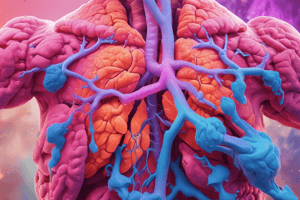Podcast
Questions and Answers
What is a common symptom of gas gangrene associated with Clostridium perfringens?
What is a common symptom of gas gangrene associated with Clostridium perfringens?
- Persistent cough
- Foul-smelling discharge (correct)
- Skin rash
- Severe abdominal cramps
What method is NOT listed as a treatment option for gas gangrene?
What method is NOT listed as a treatment option for gas gangrene?
- Food sanitation (correct)
- Antibiotic therapy
- Surgery for debridement
- Antitoxins
Which of the following conditions is associated with Clostridium difficile?
Which of the following conditions is associated with Clostridium difficile?
- Skin infections
- Food poisoning
- Pseudomembranous colitis (correct)
- Septic shock
What type of organism is Propionibacterium acnes?
What type of organism is Propionibacterium acnes?
How is food poisoning caused by Clostridium perfringens typically transmitted?
How is food poisoning caused by Clostridium perfringens typically transmitted?
What is a key characteristic of Clostridium perfringens in terms of its physiological properties?
What is a key characteristic of Clostridium perfringens in terms of its physiological properties?
What is the primary characteristic of puerperal sepsis?
What is the primary characteristic of puerperal sepsis?
Which of the following is NOT a method of infection control to prevent puerperal sepsis?
Which of the following is NOT a method of infection control to prevent puerperal sepsis?
What is a common mode of transmission for infections related to puerperal sepsis?
What is a common mode of transmission for infections related to puerperal sepsis?
Which statement accurately describes the nature of puerperal sepsis?
Which statement accurately describes the nature of puerperal sepsis?
What systemic symptom is often associated with puerperal sepsis?
What systemic symptom is often associated with puerperal sepsis?
In managing puerperal sepsis, which intervention is crucial for boosting the immune response?
In managing puerperal sepsis, which intervention is crucial for boosting the immune response?
Which symptoms are characteristic of Toxic Shock Syndrome?
Which symptoms are characteristic of Toxic Shock Syndrome?
What is a potential cause of Gastroenteritis as described?
What is a potential cause of Gastroenteritis as described?
Which of these signs is NOT typically associated with Scalded Skin Syndrome?
Which of these signs is NOT typically associated with Scalded Skin Syndrome?
What is the role of hygiene in preventing illnesses like Gastroenteritis?
What is the role of hygiene in preventing illnesses like Gastroenteritis?
What does MRSA stand for?
What does MRSA stand for?
Which of the following is true regarding the communicability of Toxic Shock Syndrome?
Which of the following is true regarding the communicability of Toxic Shock Syndrome?
Flashcards are hidden until you start studying
Study Notes
Infectious Conditions and Their Causes
-
Fiery Red Erythema (Anthony's fire) presents with erythema on face and limbs, lymphadenopathy, and systemic infection. Not communicable. Hygiene and sanitation are crucial, along with boosting immune response.
-
Puerperal Sepsis occurs during childbirth, leading to septicemia. It is classified as non-communicable. Surgical asepsis is a preventive measure.
-
Streptococcus pneumoniae:
- Gram-positive cocci forming pairs or short chains, shaped like lancets, and encapsulated.
- Causes pneumonia, presenting with fever, chills, sharp pleural pain, and blood or rusty alveolar exudate.
- Communicated through respiratory droplets, primarily affecting immunocompromised hosts. Keep protective equipment (PPE) and isolation in place to boost immune response.
-
Clostridium perfringens:
- Responsible for gas gangrene with symptoms including foul-smelling discharge, necrosis, fever, hemolysis, and possible toxemia/shock.
- Enter through spores in open wounds; treatment includes surgical debridement and antitoxins.
- Also causes food poisoning leading to diarrhea through ingestion of spores; prevention focuses on food sanitation.
-
Clostridium difficile leads to pseudomembranous colitis characterized by plaques and microabscesses due to spore ingestion, emphasizing the importance of food sanitation.
-
Propionibacterium acnes is a Gram-positive bacilli, part of the normal flora of the skin, and is non-sporeforming. Primarily associated with acne.
-
Scalded Skin Syndrome involves lesions with symptoms such as erythema, Nikolsky sign, and desquamation. Associated with MRSA or VRSA infections.
-
Toxic Shock Syndrome manifests as fever, vomiting, diarrhea, hypotension, rash, and multi-organ system involvement. It is usually non-communicable; hygiene is essential for prevention.
-
Gastroenteritis leads to symptoms of nausea, vomiting, and diarrhea without fever, primarily spread through the oral-fecal route. Hygiene and sanitation are critical for prevention.
Studying That Suits You
Use AI to generate personalized quizzes and flashcards to suit your learning preferences.




